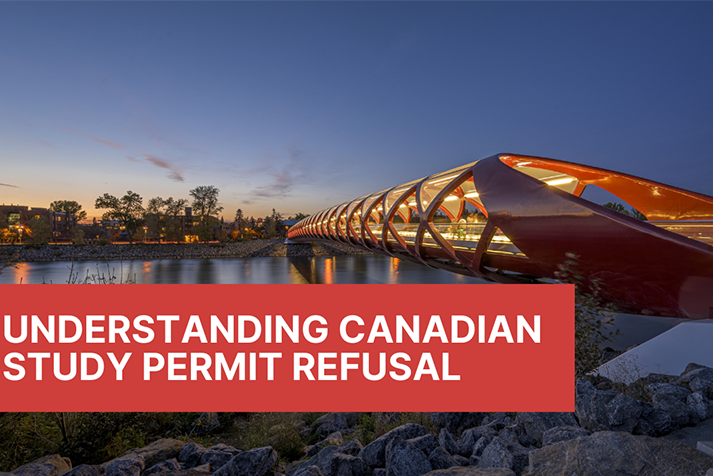21 Dec Understanding Canadian Study Permit Refusal and how to re-apply again

Canada is one of the most sought-after countries for further studies in India. There are many factors that attract students like academic excellence, research opportunities, affordability, working opportunities while learning, and immigration opportunities. Every year, lakhs of students in India apply to get a study visa in Canada.
A few days ago, multiple tweets claimed that the visa refusal rate for studies in Canada has been about 60% since the past two to three weeks. Children with high IELTS scores enrolled for online studies and AIP (Approval in Principle) visa approvals are also facing refusals. Now, refusals are not a new incident, but such a huge number of refusals in such a short time is extraordinary.
During the COVID-19 pandemic, the Canadian High Commission divided student visa approval into two stages:
- Approval in Principle (AIP): it is a temporary study visa process with two stages. After completion of stage one, a student is eligible to take online study classes.
- Stage two: Stage two involves getting permission to travel and study in Canada. For this, a student has to submit documents like biometrics, immigration medical certificate, etc.
Reasons for Refusals
A few speculations have been made as to why these many refusals are seen. These are:
- During the pandemic, direct flights to Canada were suspended. So, there is a huge backlog of over 3 to 3.5 lakh students’ applications from India. So, it is difficult for Canada to accommodate such a large number of students in just a few months when the flights resume.So, they’re refused those whose cases do not seem as strong from their courses’ perspective or the ones with sound financial conditions were refused.
- The Canadian High Commission has to now complete the work of a year in just a couple of months, and it is a difficult task.So, they are refusing the visas at this first stage to buy some time, and better prepare themselves for this backlog in the coming months. This will also give students with rejected visas some time to make a better case in their applications.
- There are several other major reasons, such as the selection of courses by the students. If a student with a weak academic record, with low scores in 10th, 12th and IELTS, chooses a tough course, refusal is inevitable. There are several students who got refused because their academic performance was low even though their IELTS score was good.In case a student with a good academic record chooses an easy course, which s/he has already done, they’re being refused. This is because the officer doesn’t see the need to do the same course again.
Other common reasons for refusal
Financial reasons
A minimum requirement for students is to provide adequate proof that the student has adequate funds for the first year of the course. If the immigration officer refuses the students if s/he feels that the student does not have enough funds.
- The applicant can escape this by focusing on having funds more than the minimum requirement. Applicants can provide proof of having sufficient funds for more than a year with documents in support of their finances. The applicant should research the cost of living in Canada and plan expenses to totally cover this ground.
Choice of the course
The Visa officer should not question the applicant’s choice of program. If the program does not go parallel with the student’s academic background, the officer will reject the case.
- If the applicants’ academic background is in line with their choice, they should attach a detailed education history with their application.
- If the applicants’ choice does not align with their academic background, they should provide a detailed personal statement to justify their choice of program.
Should academically weak students apply for a student visa in Canada?
There are a myriad of courses available for students of all streams. So, an academically weak student can apply in any of those new courses. These include artificial intelligence, data science, anthropology, and many others, which have a huge scope. Instead of opting for regular courses, these students can opt for such courses, provided their scores are good in the related choice of subject.
What is the impact of backlogs on student visa permits?
Backlogs are usually more important to the university, and they might refuse your proposal. Many institutes accept proposals on the basis of merit, while others show leniency. It depends on the institute or university on how stringent they are in this respect.
Letter of acceptance
A letter of acceptance from a Canadian Designated Learning Institute (DLI) is a must for a study permit. Moreover, if there are some minimum entry requirements, the students should meet them. If the letter of acceptance is questionable or the requirements are not met properly, the Visa Officer can refuse the application.
- The applicants should ensure that they have a letter of acceptance from a registered institute. If there are any minimum requirements, attach adequate documents to prove that they are met.
English Language Proficiency
Non-native English-speaking international students are required to prove their proficiency in English. The applicant needs to meet the minimum standardised English Language test scores like TOEFL & IELTS if they apply through Student Direct Stream (SDS) or Student Partners Program (SPP). Irrespective of whether the applicant meets the DLI ELP requirements, the applicant will be refused if the program’s requirements are unmet.
- The applicant needs to ensure that they clear the test with a good score.
Incomplete documents
If the applicant hasn’t attached proper documents like travel or identity documents, the candidate will be rejected. For example, there are too many blank spaces in the travel history, and there’s no supporting evidence for those periods. Or if the applicant hasn’t submitted proper identity documents, or they’re not readable enough.
- The applicant must ensure that all the required documents are attached with the application.
- The travel history must be justified with supporting evidence and documents.
- All the required identity documents should be submitted, and the applicant must ensure that they’re readable.
Intent of return to home
In the documents, the applicant must ensure that they have an intent to return to their home once the student permit expires. This does not include visa extensions, and the students can extend their student visas later. It is mandatory to provide the assurance that the applicant will return home and does not plan on staying in Canada after visa expiration.
- The applicant can provide this assurance by submitting a personal statement. The applicant can also provide a dual intent statement. A dual statement is for those who wish to explore the country first for educational purposes and then decide on being a permanent resident.
Lack of job prospects in the home country
Having job prospects in the home country ensures the applicant’s intent to return home. If there are none, then the candidate hopes to settle in Canada. This may result in a rejection of the student visa.
- The applicant should provide enough documents to ensure that there are enough employment opportunities after the completion of the course.
Biometrics rejection
If the applicant has any discrepancies regarding the biometrics documents, then the applicant will be straightaway refused.
- The applicants must upload the right documents and within the stipulated time.
What are the options available for the students who are rejected?
When a student gets rejected, they get a refusal letter having reasons on the basis which Visa officer has rejected the application. However, detailed reasons are not mentioned in it. The students can reapply by submitting SOP for Canada Student Visa after refusal. Moreover, if one is sceptical and wants the detailed reasons before reapplying then they can opt for GCMS (Global Case Management System), or CAIPS notes (Computer Assisted Immigration Processing System) notes.
The student will receive these notes from the office of the High Commission in approximately 40 days. Through these notes, the students can determine the basis of their refusal. After knowing the reason, they can work on addressing and overcoming the reasons.
Appeal against the refusal
Students can appeal against their refusal via the following three ways:
- re-evaluation
- Appeal against the refusal in federal court
- Submit a new application
Re-apply for a student visa
The student can re-apply again in Canada or some other country.
- Applying again in Canada: if the student is rejected in the first attempt, they can re-apply for a student visa. But, the student must identify & overcome the reason of refusal. The student can do so by preparing a detailed and strong Letter of Explanation after refusal and submit it.
- Apply for a student visa in some other country: in case the student doesn’t wish to apply again in Canada, they can always apply in some other country they see fit.
But, whichever may be the choice, the students must not waste their time. Instead, they should prepare to make a better proposal. The student should utilize their time by joining a course or internship.
When re-applying, the students must relodge their cases and write a clear Statement of Purpose (SOP). They should mention why they’re going to Canada; their post-study plans and their educational background. Students should consult a well-experienced Canadian Visa Counsellor. They’ll help in preparing a fool-proof profile that will have negligible chances of rejection.


No Comments